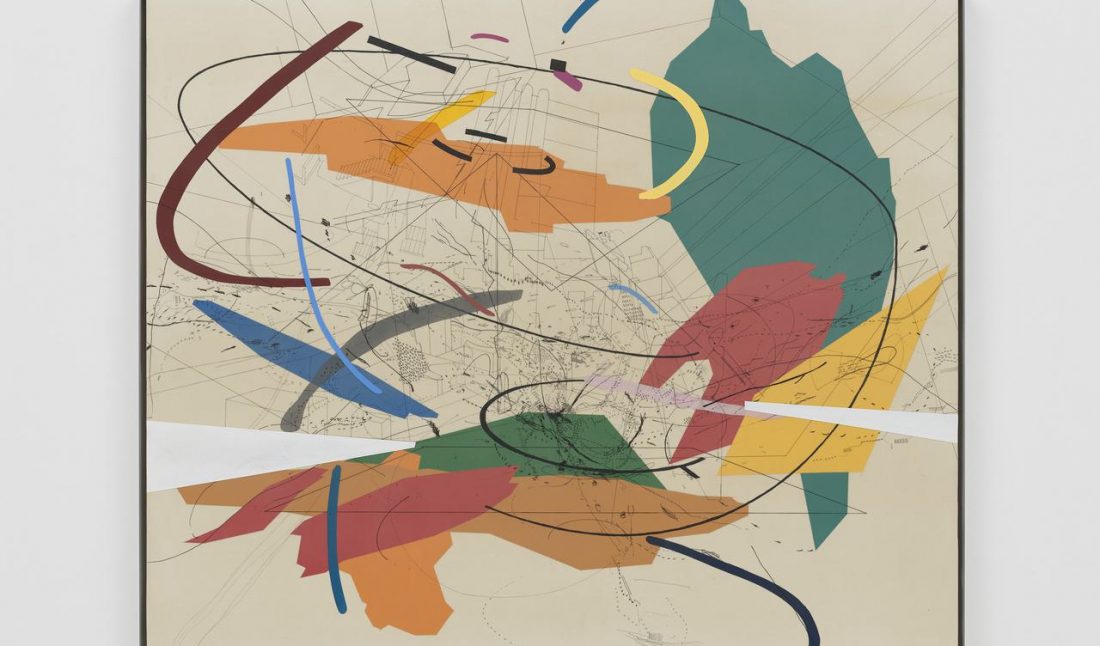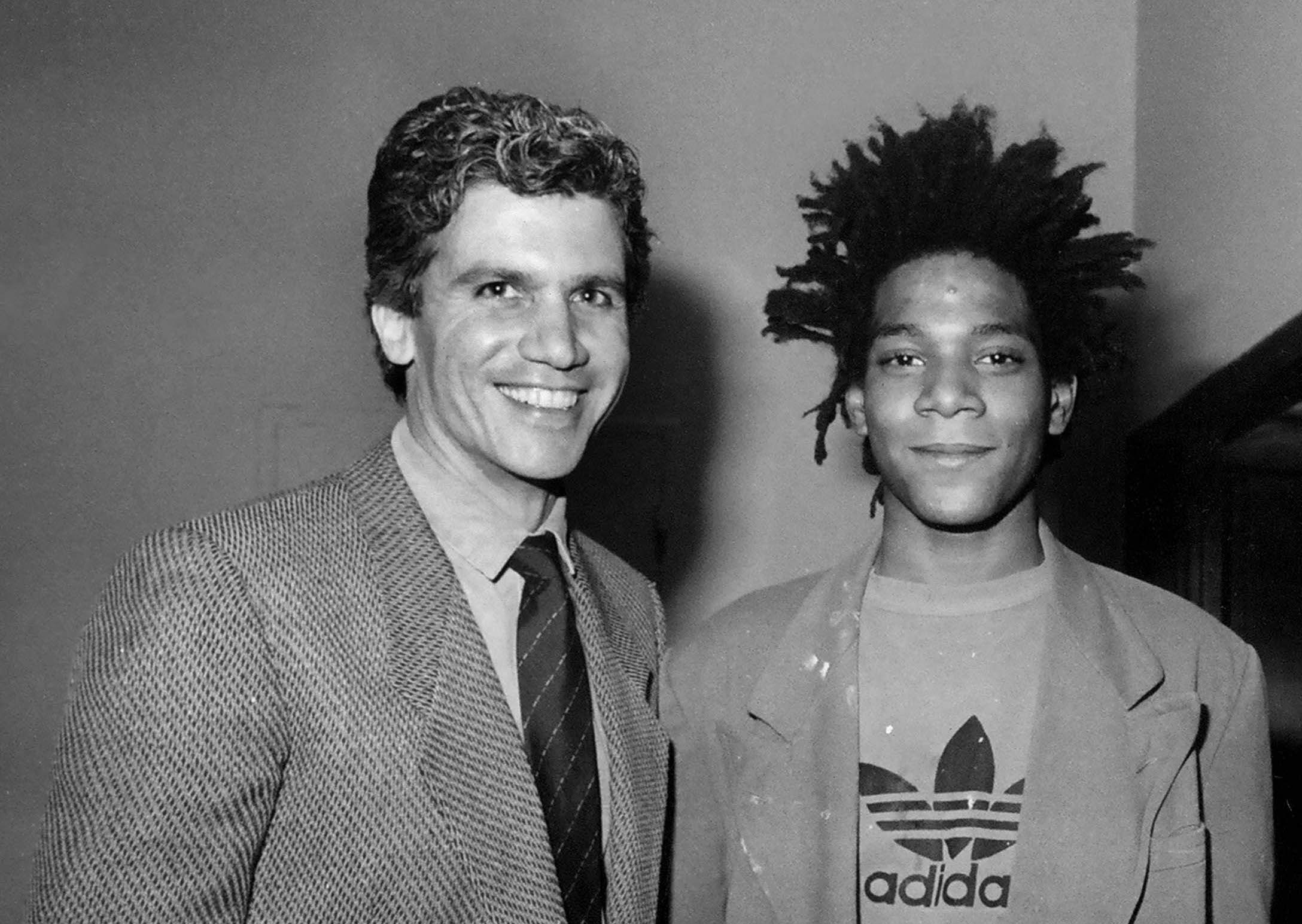Art Basel 2024 has once again cemented its position as the epicenter of the contemporary art world, assembling an extraordinary collection of works that not only captivate but provoke profound reflection. This year, standout pieces span the booths of White Cube, Gagosian, David Zwirner, Thaddaeus Ropac, Perrotin, and Pace. Each gallery presents works that transcend the ordinary, offering a profound glimpse into the minds of some of the most innovative artists of our time.
Theaster Gates, Richard Hunt, and Julie Mehretu at White Cube
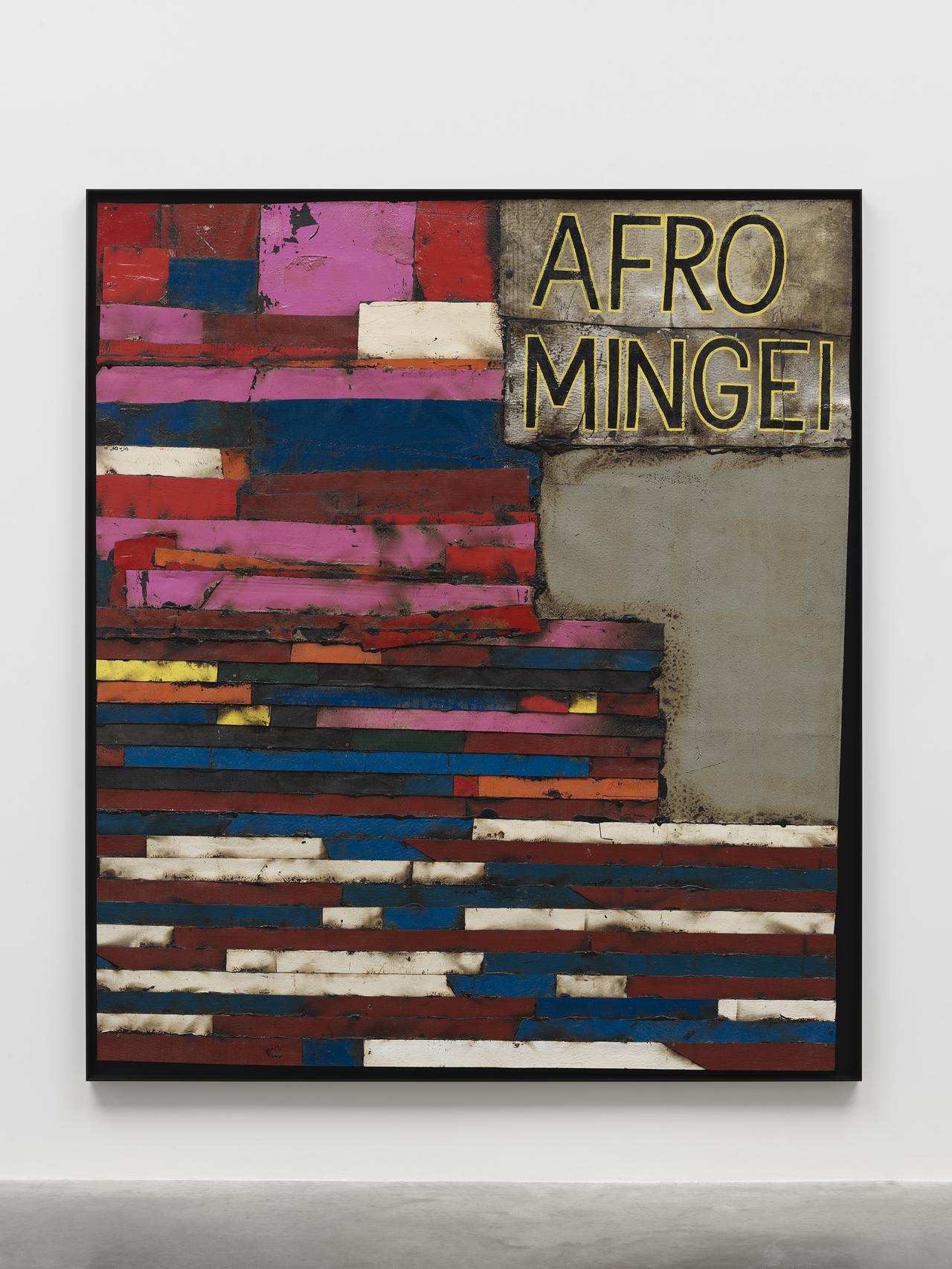 Theaster Gates, “Afro Mingei Tapestry 1”, 2024. Industrial oil-based enamel, rubber torch down, bitumen, wood and copper. Installation view, Art Basel 2024. Courtesy Theaster Gates and White Cube.
Theaster Gates, “Afro Mingei Tapestry 1”, 2024. Industrial oil-based enamel, rubber torch down, bitumen, wood and copper. Installation view, Art Basel 2024. Courtesy Theaster Gates and White Cube.
At the White Cube booth, Theaster Gates‘ “Afro Mingei Tapestry 1” (2024) commands attention with its masterful fusion of industrial and traditional materials. Gates employs industrial oil-based enamel, rubber torch down, bitumen, wood, and copper to create a tapestry that is both visually arresting and thematically rich. This work transcends conventional textile art, integrating elements of the Japanese Mingei folk art movement with African-American cultural narratives. The rugged textures and interplay of modern and traditional elements evoke a powerful dialogue about the intersections of history, culture, and modernity, inviting viewers to delve into the layered significance of the materials and motifs. Gates’ tapestry challenges the viewer to consider how industrialization and traditional craftsmanship coexist and influence each other. The use of copper and bitumen hints at themes of labor and industry, while the intricate patterns and tactile qualities of the piece draw upon a deep heritage of craft and storytelling. This juxtaposition creates a narrative that is both deeply personal and universally resonant, making “Afro Mingei Tapestry 1” a standout at the fair.
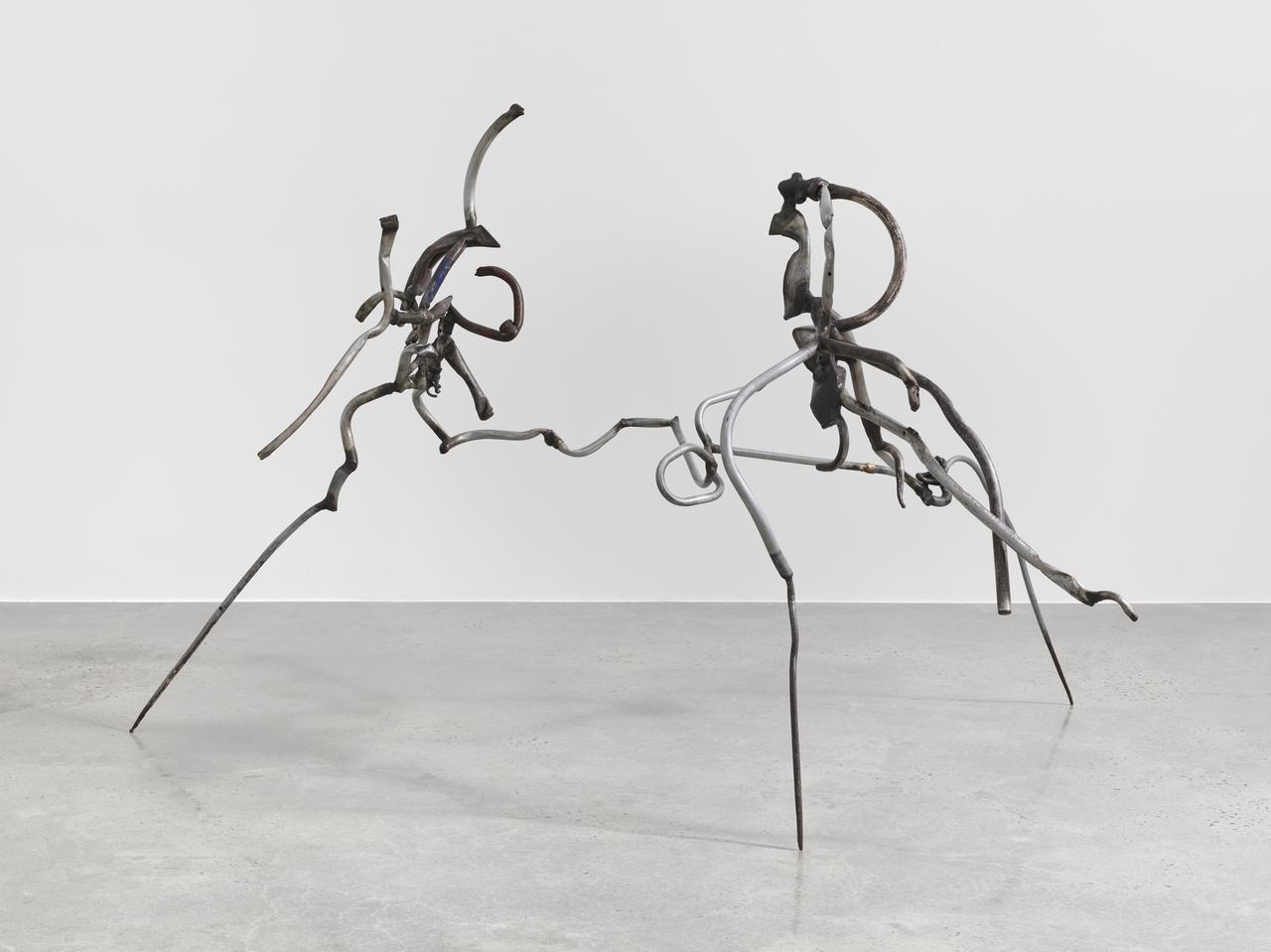 Richard Hunt: “Opposed Linear Forms”, 1961. Metal sculpture with patinated surface. Installation view, Art Basel 2024. Courtesy Richard Hunt and White Cube.
Richard Hunt: “Opposed Linear Forms”, 1961. Metal sculpture with patinated surface. Installation view, Art Basel 2024. Courtesy Richard Hunt and White Cube.
Transitioning seamlessly to another mid-century modernist master, Richard Hunt’s “Opposed Linear Forms” (1961) epitomizes the elegance and complexity of mid-20th-century abstraction. Hunt’s ability to manipulate metal into fluid, interwoven forms is on full display here. The sculpture’s patinated surface adds a timeless quality, further enhanced by the interplay of light and shadow, creating a dynamic visual experience that changes with each viewing angle. Hunt’s work embodies a sophisticated exploration of movement and tension, reflecting his innovative approach to form and space. The organic yet structured composition of “Opposed Linear Forms” suggests a dialogue between natural forces and human intervention, evoking a sense of both harmony and conflict. The viewer is invited to contemplate the inherent tension within the materials and the delicate balance achieved through Hunt’s masterful craftsmanship. This piece is not merely a static object but a dynamic entity that engages with its environment, offering a continually evolving experience.
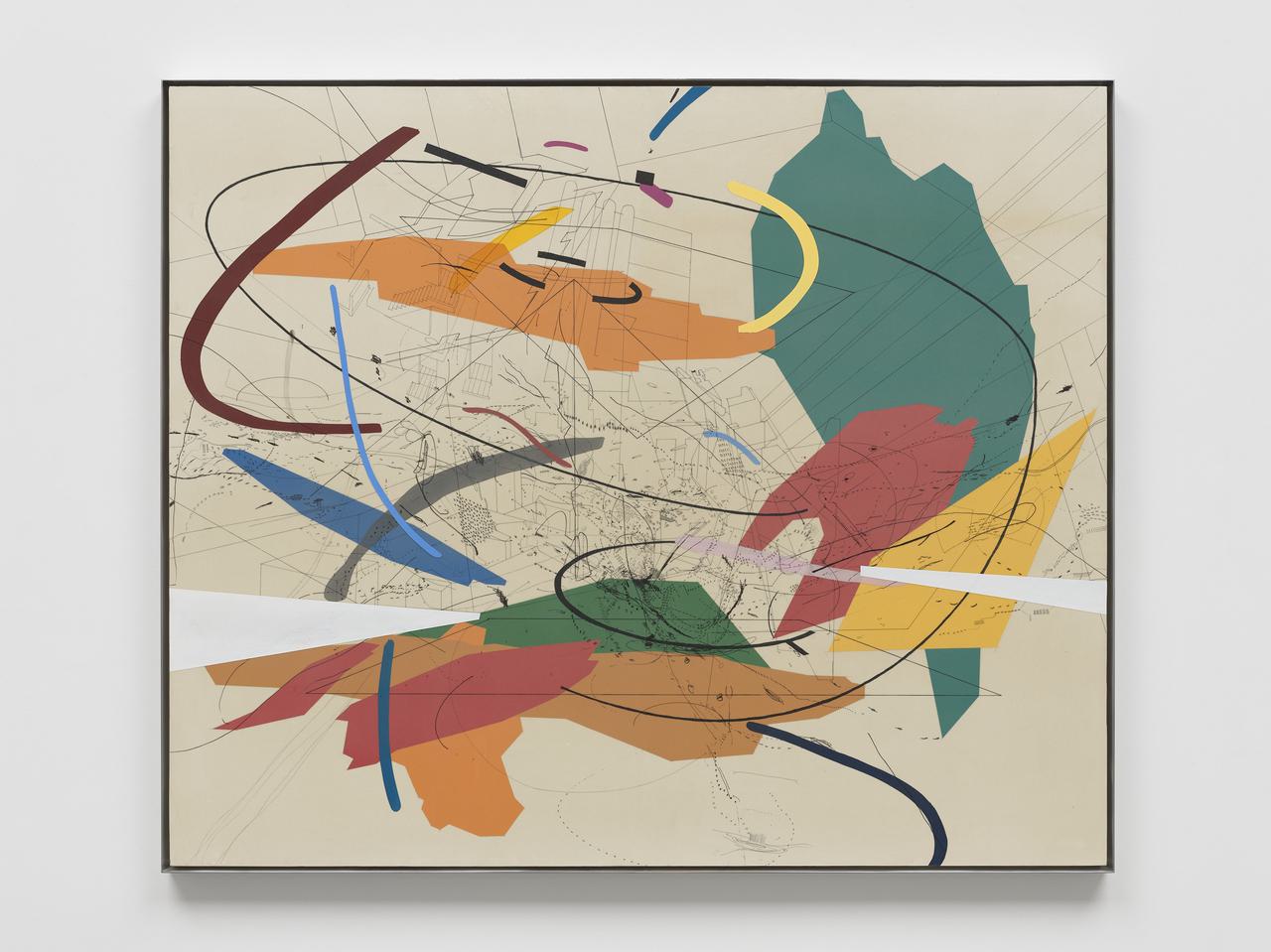 Julie Mehretu, “Untitled 2”, 1999. Mixed media on canvas. Installation view, Art Basel 2024. Courtesy Julie Mehretu and White Cube.
Julie Mehretu, “Untitled 2”, 1999. Mixed media on canvas. Installation view, Art Basel 2024. Courtesy Julie Mehretu and White Cube.
Continuing the journey through the labyrinth of contemporary abstraction, Julie Mehretu’s “Untitled 2” (1999) is a testament to her extraordinary skill in layering and composition. Known for her large-scale, dynamic works, Mehretu’s piece captures the chaos and complexity of urban landscapes through architectural drawings, gestural marks, and vibrant overlays. The immersive quality of “Untitled 2” draws viewers into its intricate details, where the lines and colors create a sense of motion and transformation. This abstract language speaks to broader themes of displacement, migration, and the interconnectedness of global cities, making Mehretu’s work a compelling highlight of Art Basel 2024. Mehretu’s use of layered transparencies and fragmented forms mirrors the multifaceted experiences of modern urban life, where history, culture, and personal narratives intersect. The piece’s chaotic energy and intricate detail compel the viewer to engage deeply, uncovering new meanings with each observation. “Untitled 2” is not just a visual experience but an intellectual journey through the complexities of contemporary existence.
Maurizio Cattelan, Urs Fischer, and Roy Lichtenstein at Gagosian
Gagosian Gallery at Art Basel 2024 is as formidable as ever, showcasing an array of compelling works. Among them, Maurizio Cattelan‘s “Sunday” (2024) stands out as a provocative commentary on economic inequality and gun violence in America. This striking piece challenges viewers to confront these pressing social issues through its bold visual narrative. The installation features stainless steel panels plated with 24-karat gold, which have been “modified” by gunfire. The gilded panels, now riddled with craters and holes, confront viewers with a stark juxtaposition of luxury and violence. Cattelan challenges the notion that wealth can offer protection, using precious metals to deconstruct the opulence associated with economic privilege, revealing its inherent fragility and vulnerability. This work references historical pieces such as Edouard Manet’s “The Execution of Emperor Maximilian” and Chris Burden’s “Shoot”, creating a powerful visual and thematic impact. Cattelan’s “Sunday” forces the viewer to grapple with the contradictions of contemporary society, where opulence coexists with violence and insecurity. The piece’s stark contrast between the pristine gold surface and the violent disruptions caused by gunfire serves as a poignant metaphor for the superficiality of wealth and the pervasive nature of social ills.
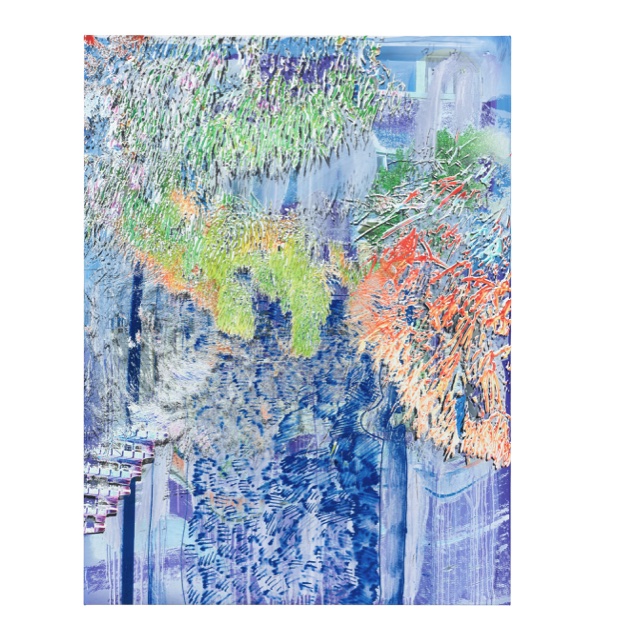 Urs Fischer, “Ozone,” 2024. Gesso, latex, and acrylic on canvas, 88 x 66 inches. Installation view, Art Basel 2024. Courtesy Urs Fischer and Gagosian Gallery.
Urs Fischer, “Ozone,” 2024. Gesso, latex, and acrylic on canvas, 88 x 66 inches. Installation view, Art Basel 2024. Courtesy Urs Fischer and Gagosian Gallery.
Adjacent to Cattelan’s work, Urs Fischer’s “Ozone” (2024) presents a striking contrast with its vibrant and imposing presence. This piece utilizes gesso, latex, and acrylic to create a textured surface that engages viewers with its tactile quality and depth. The swirling patterns and bold colors suggest themes related to the atmosphere and environmental concerns, inviting contemplation on the delicate balance of our ecosystem. Fischer’s abstract approach and large-scale execution create an almost enveloping experience, highlighting his mastery in manipulating space and form. “Ozone” evokes a visceral response, drawing attention to the environmental crises that define our times. The dynamic patterns and vivid hues convey a sense of urgency, reflecting the tumultuous state of the natural world. Fischer’s work invites viewers to consider their role in the ecological balance, making “Ozone” a poignant and timely piece.
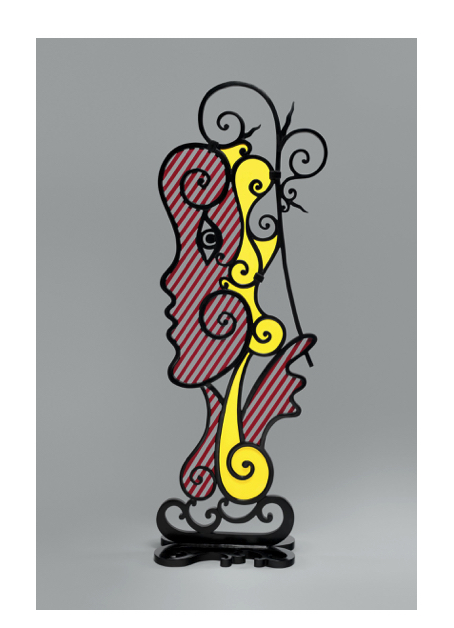 Roy Lichtenstein, “Surrealist Head,” c. 1982 (fabricated 1986–88). Painted and patinated bronze. Installation view, Art Basel 2024. Courtesy Roy Lichtenstein and Gagosian Gallery.
Roy Lichtenstein, “Surrealist Head,” c. 1982 (fabricated 1986–88). Painted and patinated bronze. Installation view, Art Basel 2024. Courtesy Roy Lichtenstein and Gagosian Gallery.
Roy Lichtenstein’s “Surrealist Head” (c. 1982, fabricated 1986–88) epitomizes his bold foray into three-dimensional art. This painted and patinated bronze sculpture, with its exaggerated features and cartoonish abstraction, blends pop art sensibilities with surrealist influences. Lichtenstein’s signature use of bold lines and primary colors, translated into a robust, tangible form, invites a playful yet thought-provoking dialogue between historical artistic movements and contemporary culture. The whimsical nature of “Surrealist Head” belies a deeper exploration of identity and perception, challenging viewers to reconsider their preconceptions about form and content. Lichtenstein’s work bridges the gap between the familiar and the surreal, creating a piece that is both accessible and intellectually stimulating.
Yayoi Kusama at David Zwirner
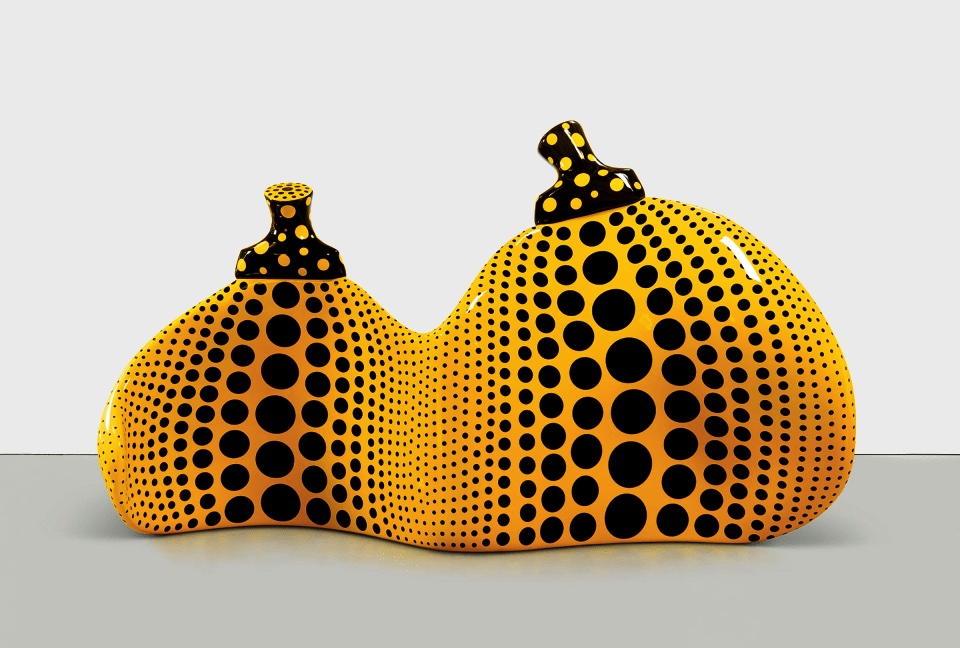 Yayoi Kusama, “Aspiring to Pumpkin’s Love, the Love in my Heart,” 2024. Bronze sculpture with polka dots. Courtesy Yayoi Kusama and David Zwirner.
Yayoi Kusama, “Aspiring to Pumpkin’s Love, the Love in my Heart,” 2024. Bronze sculpture with polka dots. Courtesy Yayoi Kusama and David Zwirner.
David Zwirner’s booth features Yayoi Kusama’s monumental sculpture, “Aspiring to Pumpkin’s Love, the Love in my Heart.” This giant bronze work, adorned with Kusama’s signature polka dots, symbolizes themes of infinity and joy. The interconnected pumpkins create a complex yet harmonious composition, their meticulously applied dots transforming the organic forms into a mesmerizing pattern. This intricate detailing reflects Kusama’s enduring fascination with the pumpkin form, offering viewers a moment of reflection on love, nature, and the infinite. Kusama’s work is a celebration of life and continuity, where each dot represents a point in an infinite continuum. The viewer is drawn into a meditative state, contemplating the boundless nature of existence and the interconnectedness of all things.
Sigmar Polke and Robert Rauschenberg at Thaddaeus Ropac
 Sigmar Polke, “Lapis Lazuli,” 1994. Lapis lazuli and resin on canvas, 240 x 200 cm. Installation view, Art Basel 2024. Courtesy Sigmar Polke and Thaddaeus Ropac.
Sigmar Polke, “Lapis Lazuli,” 1994. Lapis lazuli and resin on canvas, 240 x 200 cm. Installation view, Art Basel 2024. Courtesy Sigmar Polke and Thaddaeus Ropac.
Thaddaeus Ropac Gallery showcases Sigmar Polke’s “Lapis Lazuli” (1994), an enthralling masterpiece that highlights the artist’s innovative use of materials. The canvas, coated with lapis lazuli and resin, shimmers with a celestial quality, creating a captivating surface that is both deeply historical and strikingly contemporary. The interplay between the organic and the synthetic, a hallmark of Polke’s work, is on full display here, offering viewers a mesmerizing visual experience. “Lapis Lazuli” evokes the grandeur of the natural world while simultaneously exploring the transformative potential of human ingenuity. Polke’s use of lapis lazuli, a pigment with a rich history in art, connects the work to a broader artistic tradition, while his modern techniques push the boundaries of contemporary practice.
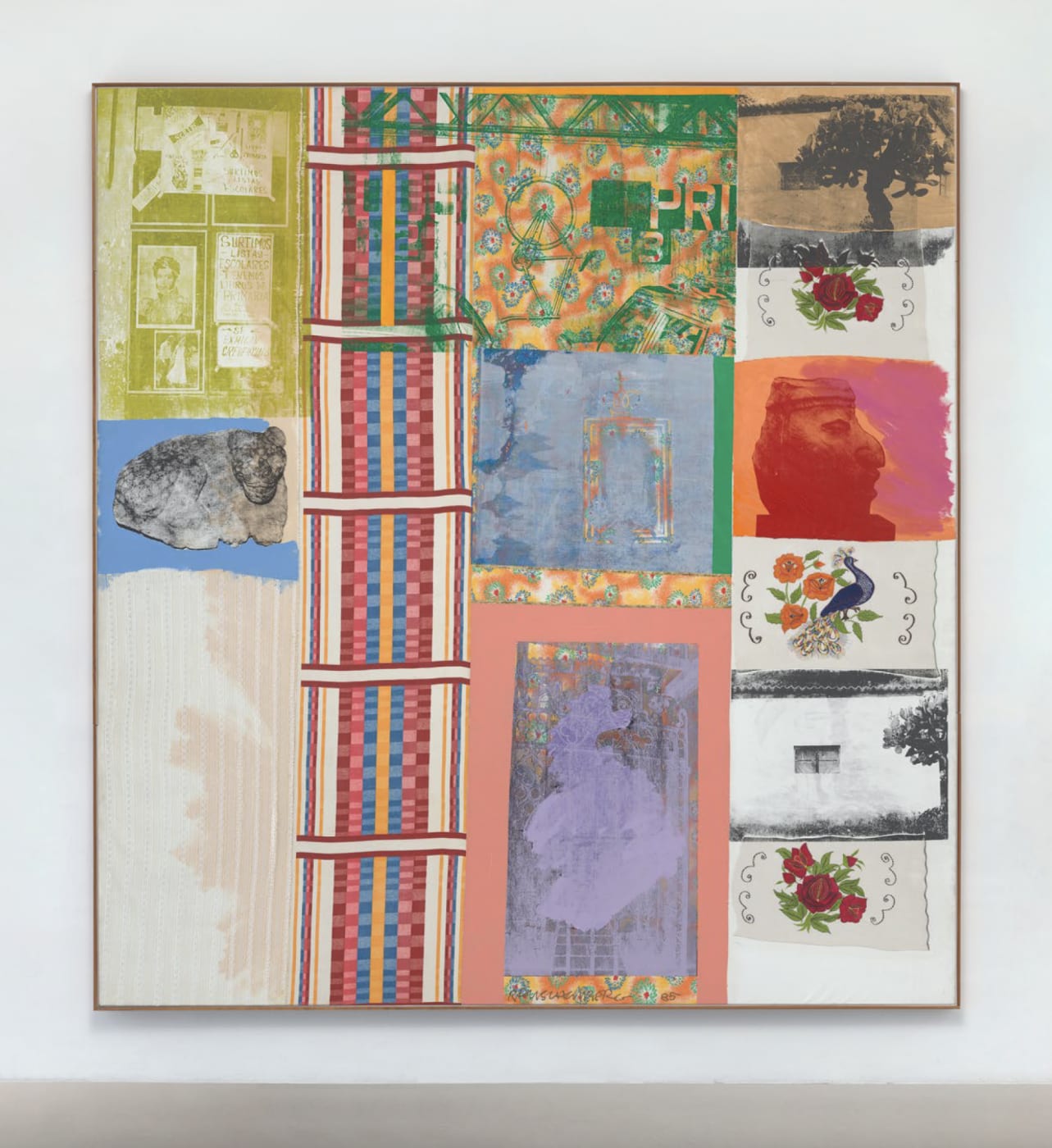 Robert Rauschenberg, “Market Altar / ROCI MEXICO,” 1985. Silkscreen ink, acrylic, fabric, and gold leaf on canvas, 313.2 x 293.1 cm. Installation view, Art Basel 2024. Courtesy Robert Rauschenberg and Thaddaeus Ropac.
Robert Rauschenberg, “Market Altar / ROCI MEXICO,” 1985. Silkscreen ink, acrylic, fabric, and gold leaf on canvas, 313.2 x 293.1 cm. Installation view, Art Basel 2024. Courtesy Robert Rauschenberg and Thaddaeus Ropac.
Robert Rauschenberg’s “Market Altar / ROCI MEXICO” (1985) exemplifies his revolutionary approach to collage and mixed media. This piece combines silkscreen ink, acrylic, fabric, and gold leaf on canvas, resulting in a rich, multifaceted composition. The dynamic layering of materials and images captures the essence of Mexican culture and history, highlighting Rauschenberg’s ability to merge diverse cultural references into a cohesive and compelling artistic statement. “Market Altar / ROCI MEXICO” is a visual tapestry that invites viewers to explore the intersections of culture, commerce, and spirituality. Rauschenberg’s innovative use of materials and imagery creates a piece that is both deeply personal and universally resonant.
Jean-Michel Othoniel at Perrotin
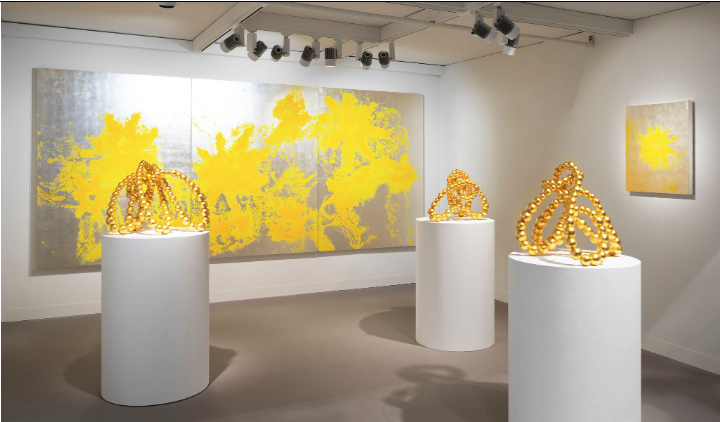 Jean-Michel Othoniel, 2023-2024. Installation view, Art Basel 2024. Courtesy Jean-Michel Othoniel and Perrotin Gallery.
Jean-Michel Othoniel, 2023-2024. Installation view, Art Basel 2024. Courtesy Jean-Michel Othoniel and Perrotin Gallery.
Perrotin Gallery presents an impressive array of works by Jean-Michel Othoniel in the Kabinett sector. Central to this showcase is Othoniel’s exploration of “emotional geometry”, a concept he develops through his long-standing collaboration with mathematician Aubin Arroyo. This collaboration delves into the theory of knots and reflections, which is exemplified in his series “Noeud Sauvage” (2023-2024). These sculptures, crafted from mirrored glass and stainless steel, capture the interplay between intuition and rationality, drawing inspiration from Jacques Lacan’s psychoanalytic theory of the Borromean knot. Notable pieces include the amber Indian mirrored glass iteration of “Noeud Sauvage” (2024) and the standard mirrored glass version from 2023. Othoniel’s “Kin No Kiku” (2024) sculptures, made from stainless steel and gold leaf, explore themes of infinity and continuity, reflecting his fascination with plant species and their symbolic associations. Complementing these is the painting “Peony, The Knot of Shame” (2014), which uses ink on white gold leaf and lithographic monotype on canvas, blending traditional and contemporary techniques to create rich textures and symbolism. Collectively, these works highlight Othoniel’s innovative artistic dialogue with mathematical concepts and natural forms, offering viewers a deep and visually captivating experience. Othoniel’s pieces challenge the viewer to consider the relationship between order and chaos, beauty and complexity, creating a profound and engaging visual narrative.
Beatriz Milhazes at Pace
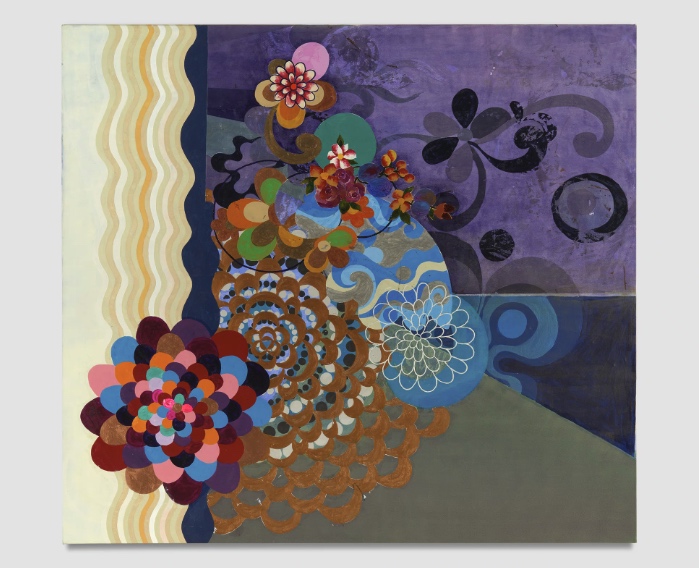 Beatriz Milhazes, “Mares do Sul,” 2001. Mono-transfer technique on canvas. Installation view, Art Basel 2024. Courtesy Beatriz Milhazes and Pace Gallery.
Beatriz Milhazes, “Mares do Sul,” 2001. Mono-transfer technique on canvas. Installation view, Art Basel 2024. Courtesy Beatriz Milhazes and Pace Gallery.
Beatriz Milhazes’s “Mares do Sul” (2001) at Pace Gallery is a vivid homage to Rio de Janeiro’s colorful coastline. The painting’s rich hues, curvilinear forms, and geometric patterns evoke the iconic design of the Copacabana promenade. Utilizing her distinctive mono-transfer technique, Milhazes creates a multilayered yet smooth-surfaced painting that captures the dynamic and intricate nature of her artistic vision. Art historian Paulo Herkenoff describes “Mares do Sul” as a “nautical apparatus of the shifting gaze”, reflecting its myriad references to Milhazes’s homeland and its renowned coastline. Milhazes’ work is a celebration of color and form, capturing the vibrancy and energy of Rio de Janeiro. The viewer is transported to the bustling streets and serene beaches of the city, experiencing the rhythms and textures of Milhazes’ homeland through her masterful use of pattern and composition.
“Despite the market slowdown, there were many museum-quality artworks represented by great female artists like Joan Mitchell at David Zwirner and Lee Krasner at Mnuchin Gallery.”
Maria Korolevskaya
“Despite the market slowdown, there were many museum-quality artworks represented by great female artists like Joan Mitchell at David Zwirner and Lee Krasner at Mnuchin Gallery. Paulina Olowska was with Pace and gave a talk together with Patrizia Sandretto Re Rebaudengo. It was a truly inspiring experience to see the interaction between artist and collector, especially after Paulina’s exhibition at Fondazione Sandretto Re Rebaudengo in Turin in 2023,” said Art curator and collector Maria Korolevskaya. “Dominique Fung had a magnificent 26-meter monumental work painted across 30 canvases at Unlimited section as well as a few works with Massimo De Carlo gallery on the first floor. Personally, I love the artistic practice of Kelly Akashi and was thrilled to see her work with Lisson gallery.”
From the cultural fusion in Theaster Gates’ tapestry to the luxurious violence in Maurizio Cattelan’s installation, each work offers a unique perspective on the complexities of modern life. These highlights not only showcase the artists’ technical prowess and innovative approaches but also invite viewers to engage with deeper themes of history, culture, and the human experience.






